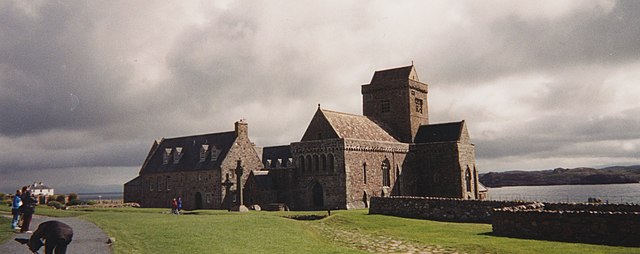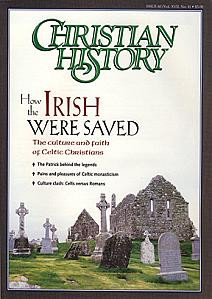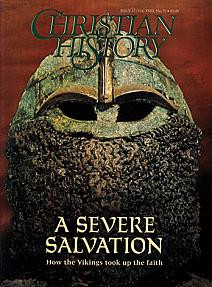VIKINGS RAIDED IONA'S MONASTERY, DEMANDING TREASURE AND DEALING DEATH

[Above: View of Iona Abbey taken in August of 2000—Libasstref / [cc0 1.0 Universal Public Domain] Wikimedia File:Iona 2000-5-Abbey.jpg I, the copyright holder of this work, hereby publish it under the following license: Creative Commons CC-Zero This file is made available under the Creative Commons CC0 1.0 Universal Public Domain Dedication.]
In 793, Viking raids on the British Isles began. The first blow of the raiders was against Lindisfarne, an island of monks off the northeast coast of today’s England. Alcuin, a noted scholar, lamented, “Behold the church of St Cuthberth spattered with the blood of the priests of God, despoiled of all its ornaments.” Two years later Vikings struck on the opposite coast, raiding a monastery in the Hebrides. This was the Irish missionary outpost on the isle of Iona. Columba had founded the island’s monastery in 563.
Its founding was prompted by a crime. Irish monks, priests, and bishops not infrequently participated in clan wars. Earlier, after founding several monasteries in Ireland, Columba copied a manuscript without its owner’s permission. Forced to give up the copy, he was furious. He led an army against the king who had made the ruling against him. The battle left many dead. When a synod exiled Columba from Ireland, he vowed to win as many souls for Christ as he had slaughtered in battle. With a dozen companions in a coracle, he sailed to Iona.
The island was barren. Columba's team built a church, huts of wood and wattle, a guest house, and a refectory. With Iona as a base, the monks planted settlements in pagan Scotland where they sought to win converts through godly lives, preaching, and practical care for their neighbors. Meanwhile, Iona prospered. Monks created artworks such as the Book of Kells. When Columba died, they placed his remains in a costly reliquary. The monks lived peaceably on their island for over two hundred years. Then came the raid in 795.
Northmen sacked Iona again in 802, burning the monastery. In an 806 raid, they killed sixty-eight monks. By then, most of the monks had moved to Kells, a monastery in Ireland that, for a time, offered safety. Iona no longer was the center of mission work but rather an outpost for a few monks living as hermits. Oddly, the monks who remained kept Columba’s reliquary. This decision cost Abbot Blaithmaic his life.
On this day, 19 January 825 [or July 24, 825, in some accounts], under cover of gloom and rain, Vikings descended on the monks in church as they concluded Mass. They slaughtered everyone but Blaithmaic. They demanded he show them where the reliquary was hidden. Blaithmaic disclaimed all knowledge. The monks had buried it. “And if, Christ willing, I were permitted to know, not to your ears would I tell it.” The furious Vikings hacked him to pieces.
In 849 Abbot Indracht dispersed the contents of Columba’s reliquary, sending part of the relics to Kells, the remainder to Dunkeld Cathedral in Scotland. Raiders (some based in Scotland, others in Ireland) sacked Iona many more times over the next two centuries. The last assault was recorded in 987.
In the following century, kings of Scotland rebuilt Iona’s church because they traced their Christian heritage to the island. Several kings of Northumberland and Scotland are buried there. Today the island lures tourists. Pilgrims longing for a link to their Christian past also visit its little, light-filled church.
—Dan Graves
----- ----- -----
Read more about Iona in "Iona's Tough Dove" in Christian History #60, How the Irish Were Saved
Read more about the Vikings in Christian History #63, A Severe Salvation







